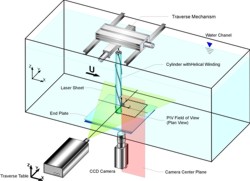
One of the actively used experimental techniques is particle image velocimetry (PIV). The figure on the right (courtesy of Dr. Nattapong Saelim, who was my lab partner at the Fluids Research Laboratory at Lehigh University) shows the basic components of a PIV setup. In this example, PIV is used to study flow patterns behind a vertical cylinder with helical windings. The flow is created in a transparent water channel, and the water is seeded with light-reflecting particles. The images of the particles, which are illuminated by a laser, are captured by a high-resolution camera. These images are then processed on a computer to yield the global instantaneous flow velocity measurements. Please, refer to the following articles for additional information:
The experimental results related to the free-surface wave interaction with a horizontal cylinder were obtained at the Fluids Research Laboratory at Lehigh University using a single-frame correlation version of film-based PIV. Presently, despite certain limitations (mostly related to spatial and temporal resolution), digital particle image velocimetry (DPIV) is taking the central stage because of the practical convenience of digital image aquisition.
At the Fluid Mechanics Laboratory at the University of Victoria,
we are employing DPIV for investigation of acoustically-coupled flows, biomedical flows, as well as flows in the reactant transport channels of fuel cells. The latter study is conducted in collaboration with Dr. Ned Djilali. The present system is capable of measuring the out-of-plane component of the flow velocity by means of stereoscopic image acquisition. In addition, our system provides a micro-PIV capability.